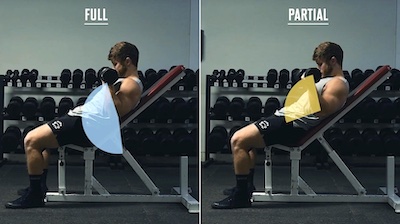
Photo source: Jeff Nippard Fitness
As fitness professionals, we have probably heard or assumed that resistance training with fROM is superior in every aspect compared to pROM. However, is this the case? How can we strategically program specific ROM to meet the needs of our clients?
#1 Meta-Analysis
In a 2023 systematic review and meta-analysis of the International Journal of Strength and Conditioning, 24 studies were analyzed on the differences between pROM and fROM (Wolf et al.). Overall, fROM slightly outperformed pROM regarding strength, power, hypertrophy, etc. This result was explained primarily by the principle of specificity and training the muscles over a long distance.
The principle of specificity states that our body will favorably adapt to perform the specific task we impose on it. This study showed that fROM training was significantly more effective than pROM training in improving fROM strength. In contrast, pROM training was only slightly better than fROM training for improving pROM strength.
Practical Applications:
● If strengthening full ROM is the goal, then training in full ROM is better than partial ROM
● Conversely, if strengthening partial ROM is the goal, then training in a partial ROM is better than full ROM
● A variety of ranges of motion have their place in a training program to meet diverse needs
This study found that training the muscle in a lengthened position mattered more than the specific range of motion. This finding means that a pROM bicep curl from the fully lengthened bottom position to halfway up yielded more gains than a bicep curl halfway up to the top in a shortened position. This is because a muscle in the lengthened position puts the muscle in greater tension than a shortened position. Tension has a substantial effect on promoting hypertrophy.
Practical Applications:
● Regardless of the trained ROM, prioritize training the muscle through a lengthened or stretched position
● Train the ROM that is safest and most comfortable
● Replacing some fROM training with pROM training may lead to larger fROM strength gains
(Note: It’s worth noting that you don’t have to choose between exclusively doing full-ROM training or exclusively doing partial-ROM training. That’s at least some indication that combining different ranges of motion may produce synergistic (not just additive) effects. Even though partial-ROM training is less effective than full-ROM training for increasing full-ROM strength in a vacuum, we see that replacing some of your full-ROM training with partial-ROM training may actually lead to larger full-ROM strength gains than exclusively doing full-ROM training, at least in some contexts. So, if you’re aiming to maximize muscle growth, it’s probably not a bad idea to train through the longest muscle lengths you — safely and comfortable — can, most of the time. But don’t be an extremist about it, especially since there’s still so much left to learn.)
#2 Systematic Review
In a 2023 systematic review from the Journal of Strength and Conditioning Research, eleven studies were reviewed to compare the effects of fROM versus pROM on training. Findings conclude that regardless of ROM (Kassiano, et al.):
● Muscles responded more favorably to hypertrophy when trained in longer positions
● Muscles trained in a shortened position often showed less hypertrophy than in lengthened positions
● Sometimes, muscles trained in a mid-ROM elicited more significant hypertrophy, such as the triceps brachii
Kassiano et al. believe training muscles in the shortened position is less effective at hypertrophic adaptations because of active insufficiency. Active insufficiency is when the contractile elements of the muscle cannot create high amounts of force, which happens in biarticular muscles when put in very short positions.
Practical Applications:
● Combine both pROM and fROM by implementing quarter or half repetitions at the bottom position of a lift after each regular repetition
#3 Systematic Review
In a 2020 systematic review from Sage Open Med, six studies with “excellent” methodological quality were reviewed to assess the effect of ROM on hypertrophy in the lower body versus the upper body. Authors Schoenfeld and Grgic point out that while there are many specific guidelines on resistance training, such as volume, training frequency, and load, little guidance is offered on ROM. Two different trains of thought exist on ROM:
- “Taking repetitions through their fROM elicits greater stimulation of fibers by maximizing the shortening and lengthening of muscle fibers”
- “pROM training uses heavy loads in a muscle’s strongest range, which conceivably leads to greater long-term hypertrophic adaptations”
The main findings suggest a substantial benefit of training fROM for the lower body, while results show both fROM and pROM benefit the upper body. Another exciting part of the review highlighted that higher loads can be used when training in pROM, increasing muscle tension. Since tension is the main factor in hypertrophy, there could be a benefit to incorporating pROM into training, as it can build more strength in the part of the ROM that is weaker than other parts.
Practical Applications:
● Choosing a ROM does not have to be a “binary choice.” Use a variety of ROMs in a training session
● “Combining ROM variations may promote synergistic effects on muscle growth”
● Use pROM to build strength in a specific muscle position, which can offer a sports performance benefit
Practical Applications
As a fitness professional, these should be your priorities when considering how ROM should be programmed to meet your client’s goals.
● Train your client in a ROM that they can control safely and that is within their joints' tolerance and ability
● Train your client in a ROM according to the specificity that their sport, job, or goal requires, not fROM by default
● When strength, power, and hypertrophy are the goals, rely primarily on fROM and long muscle length pROM
Just because research shows fROM is superior to pROM doesn’t mean that you should train your client in a large ROM that their body is not prepared for. While research demonstrates that fROM achieves more strength and hypertrophy, it is only by a minor degree. So remember the risk to reward and slowly increase the ROM to allow for safe tissue adaptation to new ranges of motion in the joints.
Even though fROM shows advantages over pROM, that doesn’t mean that pROM has no place in training. The principle of specificity states that our body will beneficially adapt to the demands placed on it. Your client may need strength or stability in a specific pROM for their sport or job, so spending extra training time in those positions may be beneficial.
Tools to Adjust Range of Motion
With all this talk about ROM, you may wonder how to adjust ROM. Aside from merely moving the joints in a small ROM, there are several tools you can use to modify ROM.

Brandon Hyatt, MS, CSCS, NFPT-CPT, NASM-CES, BRM, PPSC is an experienced leader, educator, and personal trainer with over 7 years of success in building high-performing fitness teams, facilities and clients. He aspires to become a kinesiology professor while continuing to grow as a professional fitness writer and inspiring speaker, sharing his expertise and passion. He has a master's degree in kinesiology from Point Loma Nazarene University. His mission is to impact countless people by empowering and leading them in their fitness journey.





















